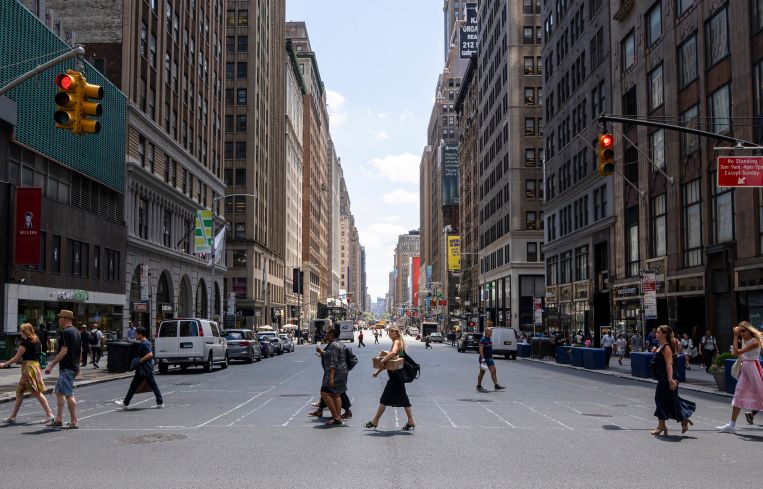Gold Rush for Manhattan Retail Space Waning, Thanks to Lack of Availability
By Abigail Nehring July 12, 2024 4:32 pm
reprints
Enthusiasm for prime retail space waned this spring as the best spaces in Manhattan got snapped up by tenants willing to pay top dollar. And activity is down even though a handful of newcomers to the city buoyed the numbers.
Rolling four-quarter leasing velocity slowed 9 percent in the second quarter of 2024 to reach 2.5 million square feet of deals, according to a CBRE report on the city’s top 16 retail corridors. That’s a 21 percent decline from the same period last year.
A slowdown was inevitable since there was a flurry of activity after the pandemic that is now coming to an end, according to Matt Chmielecki, a broker for CBRE’s tri-state retail group.
At the retail market’s peak vacancy in 2021, the city’s prime retail corridors had 290 ground-floor availabilities, according to CBRE. There are now 181 ground-floor sites available, a 2 percent decline from the 185 on the market at the end of the first quarter and a 10 percent drop year-over-year.
“A lot of the best spaces have been taken off the market,” Chmielecki said. “Then tenants said, OK, do I look at my second favorite space, my third favorite space, or do I just take a breath?’ ”
And lack of supply means landlords can try to charge more. Asking rent for prime retail space ticked up 4 percent during the quarter to $716 per square foot, an 11 percent increase year-over-year.
It’s worth bearing in mind that top-dollar retail space is still priced 36 percent below peak levels in 2014, when landlords were asking nearly $1,000 per square foot, according to CBRE.
That was unsustainable, and the retail market is now climbing out of the trough after average asking rent bottomed out at a little under $600 per square foot two years into the pandemic.
“There was a time in the city when rents were so high that the only deals getting done were one- to three-year deals,” Chmielecki said. “Then you hit a point in the middle of COVID when there were a lot of vacant spaces and tenants were trying to sign long-term deals with very low rents.”
A wave of newcomers to the city has been a bright spot in the lead-up to the summer tourism peak. Tenants new to New York took more than 163,000 square feet across 18 deals, which made up a third of leasing activity in the second quarter, according to CBRE.
Exhibit A is Los Angeles supper club Delilah’s 10,000-square-foot deal at the recently redeveloped 50 Ninth Avenue.
“Any landlord in the city would’ve bent over backward to have Delilah in their building,” Chmielecki said.
Other newcomers include Hobby Lobby’s 70,716-square-foot deal at 270 Greenwich Street — the biggest retail deal of the quarter — and apparel brand Mandelli Milano leasing 3,600 square feet at 795 Madison Avenue.
Food and beverage was the most active sector for prime retail, totaling 97,000 square feet across 20 transactions.
Italian eatery Serafina signed on for 13,000 square feet at 461 Fifth Avenue, the sector’s largest deal during the quarter.
Other notable deals on the gastronomy front include fancy steakhouse Hillstone’s renewal of 12,800 square feet at 51 Madison Avenue.
While deals were still getting done, the theme on the supply side was constriction, especially on Madison Avenue.
Only 14 storefronts were available on the prime stretch of Madison Avenue after Mandelli Milano’s deal and French perfume brand Parfums de Marly taking 501 square feet at 796 Madison Avenue.
One of the only areas in Manhattan where availability increased was SoHo, according to CBRE. That might have to do with Adidas’ departure from 115 Spring Street. Plus, Elder Statesman is leaving the nearby 150 Spring Street along with UpWest departing 107 Spring Street.
Abigail Nehring can be reached at anehring@commercialobserver.com.


